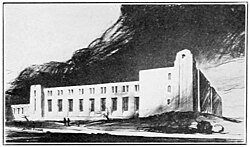Making the Prisons Safe at Night
By W. K. Daniels, Deputy Chief of the Division of Architecture.
THE problem of the control of prisons is a twofold one, involving two very separate and distinct situations.
There is the problem of day discipline, when prisoners are assigned to various tasks, and when of necessity the measure of their liberty is greatly increased.

W. K. Daniels
Then there is the problem of night control, a problem much easier of solution than that of day control of prisoners, but which nevertheless presents difficulties of a character peculiar to itself.
It is in the problem of housing criminals that the Division of Architecture enters.
Prior to the housing of the criminal, there is of course, the period of his capture and trial. Radio equipped police stations may have had a part in the capture of the criminal, and cruisers and scout ears have patrolled the city in his search. The man hunt is well under way in a few minutes time. Capture of criminals is so certain that arrangements for their housing must be made months in advance of their crimes.
Housing of criminals demands their safe custody. The problem of their safe custody at night has been better solved than that of day control. It is noteworthy that the numerous prison riots and attempted "breaks" that have occurred in various parts of the country recently have taken place during the daytime. Why? Because when the Prisoners are locked up for the night, they stay locked.
The Division of Architecture plays an important part by planning cell houses to make good this factor of night safety. At this particular time, the state through the Division of Architecture, is constructing a new unit at the Folsom State Prison. This unit consists of a cell block, hospital and administration building.
During the daylight hours and in fair weather, all prisoners except those in solitary confinement, are released from the cell house and are detailed to work, some to constructions, others to the quarry, power house, gardens, grounds, etc. One finds prisoners incarcerated for various crimes ranging from petty larceny to murder scattered to all parts of the institution grounds. During this period of the day, escapes are prevented by the river and high walls, which are commanded by elevated towers containing armed guards.
When night comes the whole prison population is placed in cells and locked up.

New cell block hospital and administration unit, Folsom State Prison.
It is obvious that these cell buildings must be escape-proof for here you have a concentration of several hundred men. many of them desperate characters. What might they not accomplish toward destruction and death under cover of darkness, if the cell buildings were not given thorough study as to planning and construction of absolute soundness and escape-proof?
A cell block is composed of a series of tiers erected inside of a fully enclosed building and constructed of heavily reinforced concrete. Should by any chance a convict free himself from his cell he would still be confined within a strong building.
The new cell block at the Folsom State Prison when completed will contain 310 cells being in tiers of five high and with a distance of 8 feet from tier to tier. The cells are constructed back to back having a utility chamber
